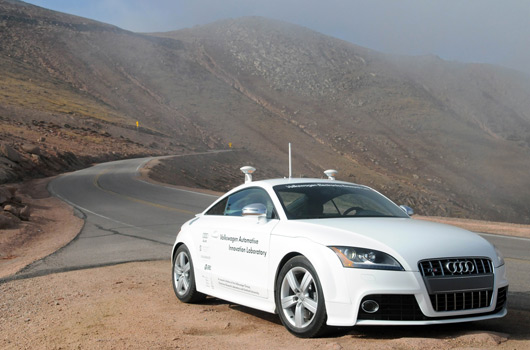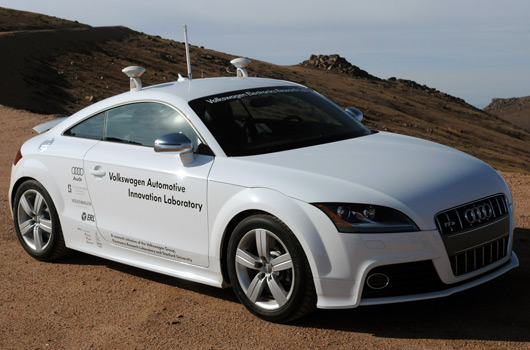An Audi TTS is being modified to tackle one of the world’s most daunting roads, the 9390ft Pikes Peak Hill Climb. nothing so newsworthy about that until you realise this car does not have a driver behind the wheel. The car currently has a whole bunch of driverless gizmos stuffed in the boot, but the propeller heads from Stanford University preparing the car plan to use real time Java algorithms to replace the driver. Live telemetry updates can be transmitted to and from the car as far as 30km away.
Dr Burkhard Huhnke, executive director of the Electronics Research Laboratory, Stanford University, said, “We believe that developing a car that can perform as well and respond as rapidly as a ‘professional’ driver, like a race or rally driver, will eventually be able to drive its way around incidents in a way that a ‘normal’ driver couldn’t.
“While a less experienced driver may freeze or make the wrong ‘correction’, the Autonomous TTS would be able to take over or guide the driver to escape from a critical situation. It could also compensate if a driver is inattentive to conditions or distracted but of course, it won’t prevent all accidents.”
While we must take Dr Huhnke’s words at face value, one doesn’t have to stretch their imagination too far to see how this technology, coupled with GPS-linked speed limiters, could make driving, well, a thing of the past.
Such an outcome would mean that classic films like Climb dance could be all we have to show our grand children to explain what fun driving used to be.
NOW AUDI BOFFINS BUILD A ‘DRIVERLESS’ SPORTS CAR
- Audi Aims To Tackle Infamous American Hill Climb Without A Driver
- Autonomous Audi TTS quattro project could ultimately benefit motorists worldwide
- Pikes Peak Hill Climb run would mark a fitting 30th anniversary for quattro technology
In its latest display of ‘Vorsprung durch Technik’ Audi is set to return to a venue synonymous with its past motorsport successes when a “driverless†TTS Coupé quattro tackles the infamous Pikes Peak Hill Climb in the USA. The non-competitive “drive†would be 30 years after the German manufacturer’s quattro permanent four-wheel-drive technology first appeared.
The Autonomous Audi TTS Coupé quattro is the direct result of work underway at the Volkswagen Group Automotive Innovation Laboratory (VAIL) – a collaborative effort set up by the Volkswagen Group Electronics Research Laboratory and Stanford University USA to advance car technology.
Currently in the testing phase, the Autonomous Audi TTS quattro is being developed for several still-to-be determined real-world driving challenges in 2010, including a possible drive up the legendary 12.42-mile Pikes Peak Hill Climb route in Colorado USA. This will not be a competition run, however, and is separate from the actual Hill Climb Championships being staged next June.
The Autonomous Audi TTS project is not aimed at making motorists, or the thrill of driving, dispensable. Instead, it is intended to explore the best capabilities of current and future driver assistance technologies to help Audi enhance the experience behind the steering wheel for future driver generations.
Dr. Burkhard Huhnke, executive director of the Electronics Research Laboratory, has noted that the technology found in the Autonomous Audi TTS quattro could help motorists respond more effectively to changing traffic conditions to reduce road congestion and allow better reactions to safety hazards. Dr. Huhnke also suggests the technology could return time to the car owners by taking care of routine driving chores, such as locating an assigned space in a car park.
Dr. Huhnke commented: “We believe that developing a car that can perform as well and respond as rapidly as a ‘professional’ driver, like a race or rally driver, will eventually be able to drive its way around incidents in a way that a ‘normal’ driver couldn’t.
“While a less experienced driver may freeze or make the wrong ‘correction’, the Autonomous TTS would be able to take over or guide the driver to escape from a critical situation. It could also compensate if a driver is inattentive to conditions or distracted but of course, it won’t prevent all accidents.â€
Audi Pikes Peak legends
For Audi, even in a non- competition format, the Autonomous TTS run would also mark the company’s return to the Pikes Peak course featuring over 156 turns and climbs 4,721 ft to the 9,390 ft summit. Bobby Unser set a new track record of 11:09.22 minutes in 1986 at the wheel of a “Pikes Peak†S1 quattro to beat the 11:25.39 set in 1985 by Michèle Mouton (Audi Sport quattro). In 1987, Walter Röhrl clocked 10:47.85 to set the first sub-11mins time in a 2.1-litre, five cylinder “Pikes Peak†quattro delivering almost 600 hp – one of the most extreme Audi quattro cars ever built.
Audi still holds several records even though Röhrl’s erstwhile record was broken in years to come. While mid-engine cars with four-wheel-drive and even with four-wheel steering compete nowadays Audi, with its road car derived front engined and steel monocoque chassis, remarkably still holds the record for a front-engined car at ‘The Peak’ after three decades have elapsed.
‘Drive by Wire’
The Volkswagen Electronics Research Lab has converted a standard Audi TTS quattro to “drive by wire†and is developing a safety system to ensure a reliable autonomous drive that can perform a vehicle shutdown if it determines conditions have become unsafe.
The Autonomous TTS is currently controlled by a computer located in the boot but next year Stanford algorithms will be running in the car using Java “real time†receiving programming updates via telemetry with a range of 20 miles. Ultimately, it is envisioned that aerial towers will be able to send and receive signals to these cars in a manner similar to cellular mobile telephone aerials today.
As a backup solution, the vehicle includes a telemetry system that can transmit all vehicle parameters to a receiving station up to 20 miles away which can also shut down the vehicle remotely, or order the safety systems to engage and bring the car to a controlled stop.
Audi is the World pioneer of the first volume production four-wheel-drive road car. Unveiled at the 1980 Geneva Motor Show (6 March), the original Audi quattro laid the foundation for the German manufacturer’s incredible domination in motorsport, transforming and redefining World rallying and more recently in touring car racing worldwide, again with production derived cars.
The Audi TTS is powered by an athletic turbocharged 2.0-litre FSI engine delivering 350 Nm of torque and is capable of taking you from 0 to 62mph in just 5.2 seconds and is currently available for a price of £33,425.00 (OTR) for the Coupé and £35,325.00 (OTR) for the Roadster in the UK. The Autonomous TTS Coupé prototype is based on this standard specification.


2 replies on “Blind turn”
[…] may remember the post from November last year about a driverless Audi TTS being prepared to conquer Pikes Peak. Stamford University are providing the technology required to […]
[…] propeller heads at Stanford University said they could do it. And now they have. “It”, of course, is the none too difficult task of sending a car up […]